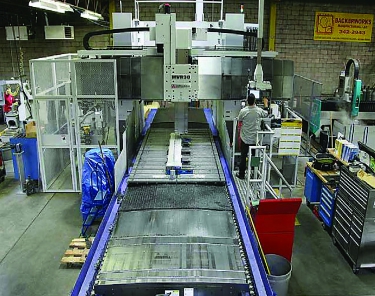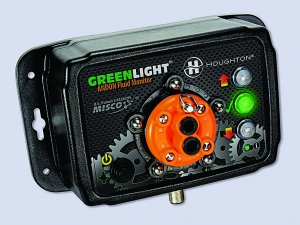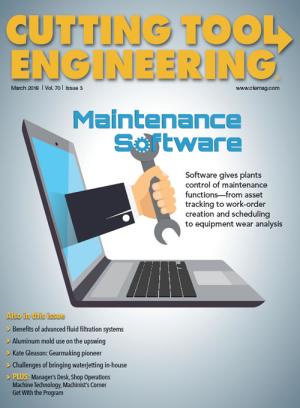END USER: Backerworks Manufacturing LLC, (505) 342-2943, www.backerworks.com
SOLUTION PROVIDERS: Axis Machine Services LLC, (505) 206-2726, www.axismachineservices.com; Houghton International Inc., (800) 666-4684, www.houghtonintl.com
CHALLENGE: Reduce the amount of coolant makeup and the sticky coolant film that forms on machine surfaces.
SOLUTION: A soluble-oil metalworking fluid for multiple-metal machining and grinding.
Although a tool may perform effectively when machining parts, sometimes a newer one is available that does an even better job. Backerworks Manufacturing LLC realized that the same holds true for coolant after changing the “liquid” tool in four of its machine tools.
The Albuquerque, N.M., job shop was running HOCUT 795 B coolant from Houghton International Inc., Valley Forge, Pa., in all of its 32 machine tools. Houghton initially developed the Boeing-approved coolant 20 years ago. It is one of the company’s best-selling coolants, according to Chris Drozdowski, manager of Houghton’s key account team and channel partners.
Pete Shufelt, owner of Backerworks, said his shop was “happy” with the coolant. However, Tom Vescuso, owner of Axis Machine Services LLC, Albuquerque, the local Houghton distributor, asked if Backerworks would like to test a new metalworking fluid called HOCUT 8640. “He told me there was a new coolant out that Houghton was pretty high on, pretty positive about,” Shufelt said.

Backerworks initially tried HOCUT 8640 in its Mitsubishi MVR 30 bridge mill. Image courtesy of Backerworks.
Shufelt, who was an NFL linebacker, formed Backerworks in a backyard garage in 1998. The shop now occupies a 24,000-sq.-ft. facility and employs more than 30 people.
Backerworks initially tried HOCUT 8640 in its Mitsubishi MVR 30 bridge mill. The machine has a 300-gal. (1,136L) sump and primarily cuts 1018 steel and 304 stainless steel. Shufelt said he was hesitant to change from an effective coolant to one that might work better.
After the switch, however, his feelings changed when he received positive feedback from his machinist. The new coolant provides enhanced wetting properties, reducing consumption (because of drag-out on parts and less evaporation), and its dispensability improves chip removal, minimizing machine downtime, according to Houghton.
The shop then switched the coolant in three other machines. These include a Haas VF 9 vertical machining center, which has a 95-gal. (360L) sump and primarily cuts 4340 steel and 400-series stainless, and a DMG Mori eVo 80 5-axis mill/turn machine, which has a 500-gal. (1,893L) sump.
“Since switching to the new Houghton coolant, our shop has realized many benefits, including less product usage, as operators report having less weekly makeup,” Shufelt said. “The product runs very clean, so windows and other machine surfaces are not left with the sticky film we have seen with other brands. Tool life is also great across all the alloys we machine.”
Because the shop is located in a Southwestern desert, the region’s dry climate and low humidity increase coolant makeup, especially during the summer, Drozdowski said. With the new coolant, “operators were noticing that they were using less makeup in their weekly top-off of the machines, because you have to add product and water due to evaporation.”

Houghton installed a Greenlight “Andon” fluid monitor on the Mitsubishi MVR 30 bridge mill’s 300-gal. sump. Image courtesy of Houghton International.
Shufelt added that with the new coolant, the concentration remains more consistent. That’s easy to determine on the Mitsubishi bridge mill. Houghton installed a Greenlight “Andon” fluid monitor from its equipment division on the machine’s sump. (According to Houghton, andon is a Japanese term used in lean manufacturing. It refers to a system of alerting workers to a quality or process problem.)
In operation, if the required coolant concentration range is from 6 to 8 percent, the Andon’s center light illuminates green when it’s within that range. However, one of two lights will illuminate yellow if the concentration is slightly out of range, low or high, and one of two of those lights will illuminate red if the concentration is substantially outside the acceptable range.
Now when he enters the shop in the morning, Shufelt sees a green light, he said. “There will be a red light every so often; it was daily with the other coolant, especially during the summer months.”
Another color that’s frequently seen in the shop is white. “I can go to the VF 9 right now and see the translucent white coolant,” Shufelt said. “It just looks like it is fresh coolant all the time.”
Rather than prematurely dump coolant that still has life, Shufelt said he will eventually switch all his machines to HOCUT 8640. “I’m hoping to do that by spring.”
Until then, he is happy about the coolant used throughout the shop but appreciates what the new “tool” has to offer.
“This stuff takes you to another level,” Shufelt said. “I’m big into my machines, and it doesn’t mess up my machines. And we get really great cutter performance. I’m big into that too.”
Related Glossary Terms
- alloys
alloys
Substances having metallic properties and being composed of two or more chemical elements of which at least one is a metal.
- coolant
coolant
Fluid that reduces temperature buildup at the tool/workpiece interface during machining. Normally takes the form of a liquid such as soluble or chemical mixtures (semisynthetic, synthetic) but can be pressurized air or other gas. Because of water’s ability to absorb great quantities of heat, it is widely used as a coolant and vehicle for various cutting compounds, with the water-to-compound ratio varying with the machining task. See cutting fluid; semisynthetic cutting fluid; soluble-oil cutting fluid; synthetic cutting fluid.
- grinding
grinding
Machining operation in which material is removed from the workpiece by a powered abrasive wheel, stone, belt, paste, sheet, compound, slurry, etc. Takes various forms: surface grinding (creates flat and/or squared surfaces); cylindrical grinding (for external cylindrical and tapered shapes, fillets, undercuts, etc.); centerless grinding; chamfering; thread and form grinding; tool and cutter grinding; offhand grinding; lapping and polishing (grinding with extremely fine grits to create ultrasmooth surfaces); honing; and disc grinding.
- lean manufacturing
lean manufacturing
Companywide culture of continuous improvement, waste reduction and minimal inventory as practiced by individuals in every aspect of the business.
- machining center
machining center
CNC machine tool capable of drilling, reaming, tapping, milling and boring. Normally comes with an automatic toolchanger. See automatic toolchanger.
- metalworking
metalworking
Any manufacturing process in which metal is processed or machined such that the workpiece is given a new shape. Broadly defined, the term includes processes such as design and layout, heat-treating, material handling and inspection.
- milling machine ( mill)
milling machine ( mill)
Runs endmills and arbor-mounted milling cutters. Features include a head with a spindle that drives the cutters; a column, knee and table that provide motion in the three Cartesian axes; and a base that supports the components and houses the cutting-fluid pump and reservoir. The work is mounted on the table and fed into the rotating cutter or endmill to accomplish the milling steps; vertical milling machines also feed endmills into the work by means of a spindle-mounted quill. Models range from small manual machines to big bed-type and duplex mills. All take one of three basic forms: vertical, horizontal or convertible horizontal/vertical. Vertical machines may be knee-type (the table is mounted on a knee that can be elevated) or bed-type (the table is securely supported and only moves horizontally). In general, horizontal machines are bigger and more powerful, while vertical machines are lighter but more versatile and easier to set up and operate.
END USER: Backerworks Manufacturing LLC, (505) 342-2943, www.backerworks.com
SOLUTION PROVIDERS: Axis Machine Services LLC, (505) 206-2726, www.axismachineservices.com; Houghton International Inc., (800) 666-4684, www.houghtonintl.com
CHALLENGE: Reduce the amount of coolant makeup and the sticky coolant film that forms on machine surfaces.
SOLUTION: A soluble-oil metalworking fluid for multiple-metal machining and grinding.


